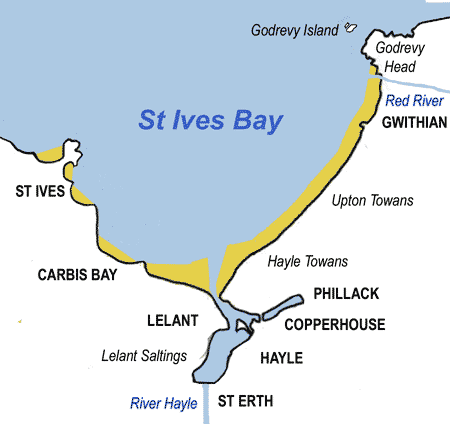
Phillack
Encyclopedia

Parish
A parish is a territorial unit historically under the pastoral care and clerical jurisdiction of one parish priest, who might be assisted in his pastoral duties by a curate or curates - also priests but not the parish priest - from a more or less central parish church with its associated organization...
) in west Cornwall
Cornwall
Cornwall is a unitary authority and ceremonial county of England, within the United Kingdom. It is bordered to the north and west by the Celtic Sea, to the south by the English Channel, and to the east by the county of Devon, over the River Tamar. Cornwall has a population of , and covers an area of...
, United Kingdom
United Kingdom
The United Kingdom of Great Britain and Northern IrelandIn the United Kingdom and Dependencies, other languages have been officially recognised as legitimate autochthonous languages under the European Charter for Regional or Minority Languages...
. It is situated approximately one mile (1.6 km) northeast of Hayle
Hayle
Hayle is a small town, civil parish and cargo port in west Cornwall, United Kingdom. It is situated at the mouth of the Hayle River and is approximately seven miles northeast of Penzance...
and half-a-mile (0.8 km) inland from St Ives Bay
St Ives Bay
St Ives Bay is a bay on the Atlantic coast of north-west Cornwall in the United Kingdom. It is in the form of a shallow crescent, some 4 miles or 6 km across, between St Ives in the west and Godrevy Head in the east....
on Cornwall's Atlantic coast. The village is separated from the sea by a range of high sand dunes known as The Towans
The Towans
The word 'towan' means 'sand dune' in Kernewek, the Cornish language and occurs in numerous placenames . However, The Towans usually refers to the three-mile stretch of coastal dunes which extends north east from the estuary of the River Hayle to Gwithian beach with a mid-point near Upton...
.
Phillack has been in the civil parish
Civil parish
In England, a civil parish is a territorial designation and, where they are found, the lowest tier of local government below districts and counties...
of Hayle since 1935; before that it was a separate parish in its own right. Phillack parish was originally in Redruth Registration District but the village now comes under Camborne-Redruth Registration District.
There is some dispute over the origins of the name. In the 17th century, Phillack was believed to refer to the Irish Saint Felicitas who is said to have founded Phillack church in the 6th century. However, a 10th century Vatican
Vatican Library
The Vatican Library is the library of the Holy See, currently located in Vatican City. It is one of the oldest libraries in the world and contains one of the most significant collections of historical texts. Formally established in 1475, though in fact much older, it has 75,000 codices from...
codex mentions a Saint Felec of Cornwall
Felec of Cornwall
Saint Felec or Felix of Cornwall was an obscure 5th or 6th century British saint active in the country's south-western peninsula. Saint Felix was said to have had the miraculous gift of being able to communicate with lions, cats, and other feline creatures. The church at Phillack, near Hayle is...
who is believed to have lived about the same time and may be dedicatee of the parish church
Parish church
The church was originally the parish church also of Hayle: it was built in the 15th century and rebuilt in 1856 by William WhiteWilliam White (architect)
William White, F.S.A. was an English architect, famous for his part in 19th century Gothic Revival architecture and church restorations...
but the tower is original. The font is probably not medieval; half a coped stone is in the churchyard.
Antiquities
Two early stones have been found embedded in the original village church. One bears a 'Constantine' form of a Chi-Rho cross which may date to the 5th century; it was afterwards rebuilt into the wall directly above the apex of the arch of the doorway of the new church. The second is simple memorial stone bearing the name of 'Clo[tualus] [son of] Mo[bra]ttus', dated between the fifth to eighth centuries, and now stands in the churchyard. Arthur G. Langdon (1896) recorded the existence of six stone crosses in the parish, including two in the churchyard.Notable residents
The geologist and philanthropist Elizabeth CarneElizabeth Catherine Thomas Carne
Elizabeth Catherine Thomas Carne , author, fifth daughter of Joseph Carne, F.R.S., was born at Rivière House, in the parish of Phillack, Cornwall, United Kingdom, on 16 Dec...
was born here.
The Devon clergyman Richard Carpenter
Richard Carpenter (theologian)
- Biography :He was probably born in Cornwall in 1575. A Richard Carpenter was baptized at Phillack, Cornwall, on 16 February 1575[/6], son of Thomas Carpenter. It is not certain, however, that he and this Richard Carpenter were the same person. He matriculated at Exeter College, Oxford, on 28 May...
may have been born here in 1575.

